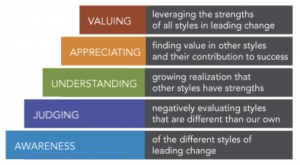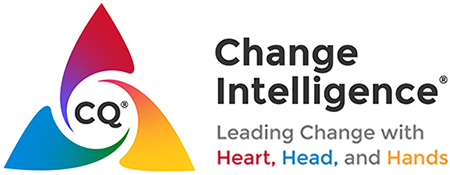 “I thought I came here today to learn more about myself,
“I thought I came here today to learn more about myself,
in order to help me do my job to manage change.
What I really learned was empathy for other people,
which will help me partner with others to lead change.”
This revelation was shared by a Change Intelligence (CQ) workshop participant, and one that I’ve heard many times from many others. The definition of CQ is the awareness of one’s change leader style, and the ability to adapt one’s style to be optimally effective across people and situations. As a person builds awareness of their own style, they naturally become aware of other styles of leading change. The Heart-oriented change leader gets exposed to Head-oriented change leaders, increasing their awareness of the need to make progress toward the goal while taking care of the people. Head-oriented change leaders get exposed to Hands-oriented change leaders, increasing awareness of process and tactics in addition to vision and strategy.
At times, due to how we are hard-wired as humans, “different” can be perceived as “bad” – in the same way that “change” can be perceived as “threat” when we first encounter it – no matter how pro-diversity or change-friendly we might be deep down inside. What I’ve often observed, in myself and others, is that once we become aware of other styles, we can initially judge them negatively. For example, I am a high-Heart-and-Head change leader – the Champion change leader style. Early in my career, I looked down on high-Hands Executers, criticizing them as “plodding” and “pessimistic.”
However, over time, particularly once I realized that some of my early change projects were veering off-track because of a lack of focus on the details, I began to see the value of efficient planning. What I once perceived as plodding I began to appreciate as keeping a firm handle on activities, deliverables, issues and risks, so nothing got dropped out. What I once perceived as pessimistic I began to appreciate as a realistic appraisal of resource requirements and timing targets.
I’ve seen such a realization occur time and again in the change leaders I coach – no matter their industry, functional expertise, or hierarchical level. I refer to this as the “judging to valuing ladder” as we transition from being an “aware” to an “evolved” change leader:

What happens when people step up the ladder is that they begin to empathize with a much wider array of people than they may have in the past. They begin to understand the journeys others have been on, and appreciate that they are honestly trying to do the best they can capitalizing on their strengths. That is a huge mental shift, because so often, to the “unenlightened change leader,” the strengths of other styles can seem very frustrating and even detrimental – like my initial judgment of planning as plodding and realism as pessimism.
When we are able to “get out of our heads” (or “hearts” or “hands” or whatever our dominant style may be), magic happens. As the old saying goes, “it’s amazing how when we change, others change too.” When we look at people with new eyes – with respect and gratitude – it’s a palpable gift to them. We “show up” very differently to them as well. At the top of the judging to valuing ladder, the door to new possibilities for partnership opens.
To put these insights into practice right now, I invite you to ask yourself:
Is there someone you are working with who you find frustrating? Looking at them through the lens of empathy, could they be honestly trying to do the right thing, but just in a very different way than you would? Might they possibly be leveraging strengths that they genuinely believe will lead to successful outcomes, but those strengths may not be ones you value?
Is there someone you are working with who you are trying to influence in a positive direction, but not getting traction? Consider that perhaps you have been communicating with them in a way that works for you, but not in a way that they can truly “hear.” For example, as a high-Heart-and-Head Champion change leader, I tend to get excited by the “what” and “who” of change – that is, the exciting new vision and engaging with people to get there with urgency. To connect with high-Hand Executer change leaders, I need to incorporate “how” messages. If I don’t, then they will be stuck ruminating about “how are we going to make this work,” and often view me as a “cheerleader” not a “champion,” because I have not helped them see the path from current to future state, which is what they need to know to connect with my message.
Is there a change initiative you are leading in which you are stuck and not achieving the results you aspire to? Study the strengths of change leader styles that are not your own, ones that are less typical or even uncomfortable for you. Can you try out one or more of these strengths, flexing some new muscles in areas you have traditionally been weak, or under-valued? Is there a colleague you can reach-out to who is strong in critical aspects of the change process that you are not as skilled at, or just do not enjoy?
Daniel Goleman, who popularized “Emotional Intelligence” or “EQ” (which encourages us to hone our capacity to understand and manage our own emotions) has in more recent times developed the concept of “Social Intelligence,” to empower us to forge effective relationships with others. In his words, “self-absorption in all its forms kills empathy, let alone compassion. When we focus on ourselves, our world contracts as our problems and preoccupations loom large. But when we focus on others, our world expands. Our own problems drift to the periphery of the mind and so seem smaller, and we increase our capacity for connection – or compassionate action.”
The first step in building Change Intelligence, or CQ, is in fact to look within, and become aware of own change leader style. However, the true gold is when we can then build on this understanding to empathize with others, and adapt our style accordingly. Thinking about all the tumult in our workplaces and our world, it can seem “scary out there.” So many people are living and working in fear. By developing and displaying empathy, we can not only help others and ourselves rise above that fear, but we also vastly increase the probability of successful partnerships and sustainable change.
